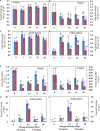Melatonin Alleviates Chilling Injury Symptom Development in Mango Fruit by Maintaining Intracellular Energy and Cell Wall and Membrane Stability
- PMID: 35845799
- PMCID: PMC9280488
- DOI: 10.3389/fnut.2022.936932
Melatonin Alleviates Chilling Injury Symptom Development in Mango Fruit by Maintaining Intracellular Energy and Cell Wall and Membrane Stability
Abstract
The efficacy of the signaling molecule melatonin for alleviating chilling injury (CI) in mango (Mangifera indica L.) fruit was studied to investigate the potential role of membrane integrity, energy charge, and ripening-related changes in the development of CI, and its management by melatonin. 'Langra' and 'Gulab Jamun' cultivar mango fruit was immersed in 100 μM of melatonin before storage for 28 days at 5°C with weekly transfers to shelf life at 25°C. CI symptom development was associated with compositional and enzymatic aspects of textural changes, cell membrane deterioration, and chemical energy status. Melatonin-treated 'Langra' fruit exhibited very low CI (5 vs. 21%) while 'Gulab Jamun' fruit exhibited higher CI (36 vs. 38%) during 28 days of storage at 5 ± 1°C. Higher chilling tolerance in melatonin-treated 'Langra' was associated with lower softening, ascribed to lower cell wall degrading exo- and endo-polygalacturonase, pectinesterase, and endo-1,4-β-D-glucanase. In addition, lower membrane deteriorating-phospholipase D and lipoxygenase activity in melatonin-treated 'Langra' corresponded to lower palmitic and stearic acids and higher oleic, linoleic, and linolenic acids accumulation, thus, higher unsaturated/saturated fatty acids ratio. Additionally, there was a higher intracellular energy supply with melatonin, represented by a higher adenylate energy charge (AEC) arising from higher ATP and ADP and lower AMP accumulation, related to higher H+-ATPase, Ca2+-ATPase, succinate dehydrogenase, and cytochrome c oxidase activities. This study for the first time provides evidence, suggesting that melatonin alleviation of CI is related to the preservation of membrane integrity, thereby protecting the intracellular energy supply, and preserving cell wall integrity via impeding cell wall degrading enzyme activities.
Keywords: Mangifera indica; cell wall-degrading; cold storage; intracellular energy; membrane integrity.
Copyright © 2022 Bhardwaj, Aghdam, Arnao, Brecht, Fawole and Pareek.
Conflict of interest statement
The authors declare that the research was conducted in the absence of any commercial or financial relationships that could be construed as a potential conflict of interest.
Figures





References
-
- Tharanathan R, Yashoda H, Prabha T. Mango (Mangifera indica L.),“The king of fruits”—an overview. Food Rev Int. (2006) 22:95–123. 10.1080/87559120600574493 - DOI
-
- Ribeiro SMR, Schieber A. Bioactive compounds in mango (Mangifera indica L.). In: Wattson R, Preedy V. editors. Bioactive Foods in Promoting Health. Amsterdam: Elsevier; (2010). p. 507–23.
-
- Ibarra-Garza IP, Ramos-Parra PA, Hernández-Brenes C, Jacobo-Velázquez DA. Effects of postharvest ripening on the nutraceutical and physicochemical properties of mango (Mangifera indica L. cv Keitt). Postharvest Biol Technol. (2015) 103:45–54. 10.1016/j.postharvbio.2015.02.014 - DOI
-
- Bhardwaj R, Pareek S, González-Aguilar GA, Domínguez-Avila JA. Changes in the activity of proline-metabolizing enzymes is associated with increased cultivar-dependent chilling tolerance in mangos, in response to pre-storage melatonin application. Postharvest Biol Technol. (2021) 182:111702. 10.1016/j.postharvbio.2021.111702 - DOI
-
- Bhardwaj R, Pareek S, Saravanan C, Yahia EM. Contribution of pre-storage melatonin application to chilling tolerance of some mango fruit cultivars and relationship with polyamines metabolism and γ-aminobutyric acid shunt pathway. Environ Exp Bot. (2022) 194:104691. 10.1016/j.envexpbot.2021.104691 - DOI
LinkOut - more resources
Full Text Sources
Miscellaneous

